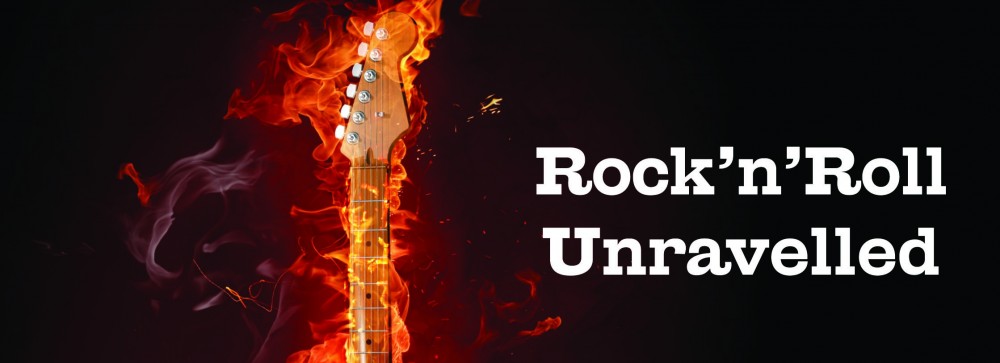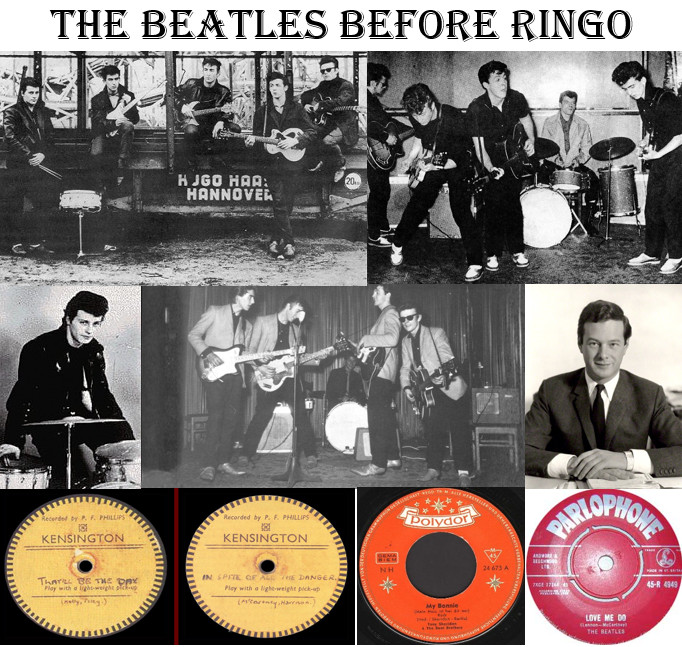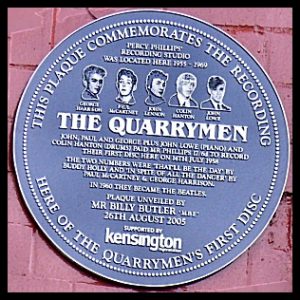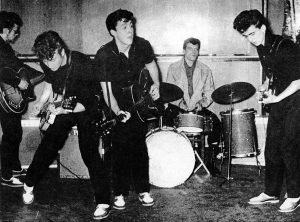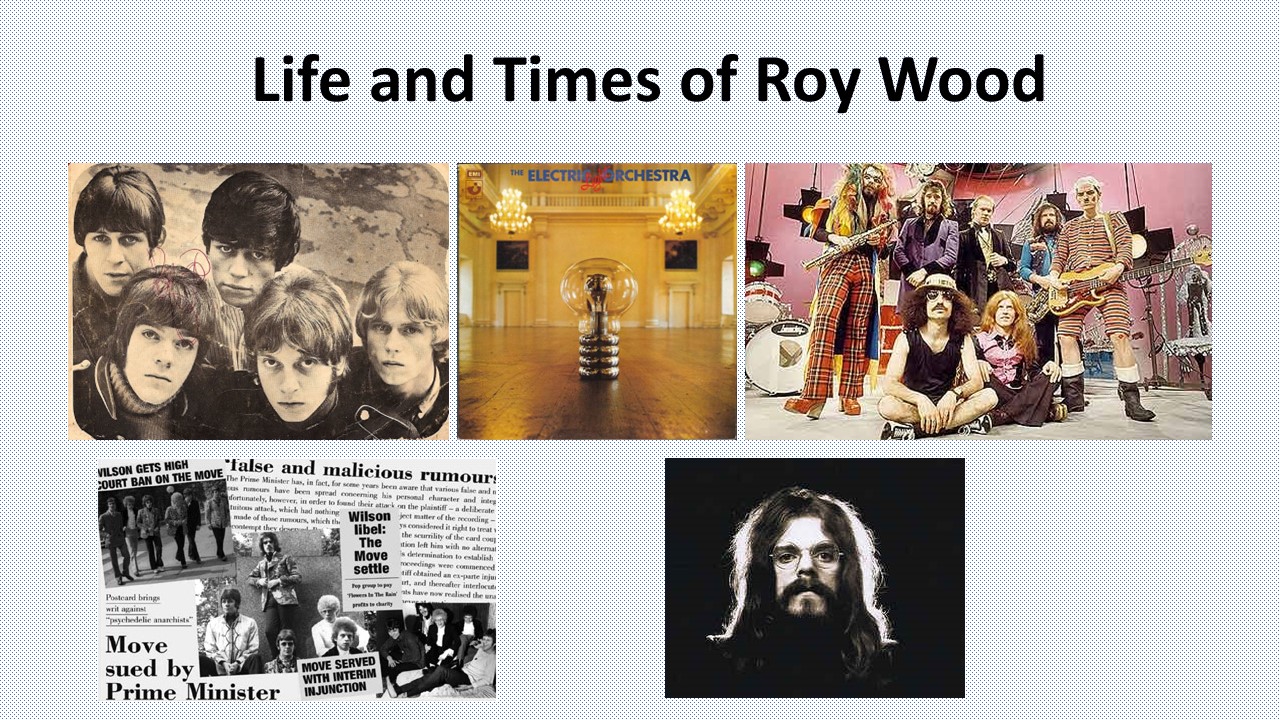THE BEATLES BEFORE RINGO STARR
Beatles Before Ringo Starr – The story of the Beatles before they became the Fab Four, when Ringo joined. They spent five years slogging away, before Love Me Do took them into the UK charts on 11 October 1962.
To see which of the bands talked about in the show
are ON TOUR NOW
PODCAST associated with this blog
The Beatles Before Ringo Starr
IT ALL STARTED…
early 1957: John Lennon and Paul Shotton formed the Black Jacks.
March 1957: The Black Jacks renamed to the Quarry Men.
They both attended, Quarry Bank High School and this gave them the inspiration for the group’s name.
JOHN MET PAUL – THE QUARRY MEN
6 July 1957: John Lennon met Paul McCartney
Ivan Vaughan took his friend Paul McCartney to see John Lennon perform with his group the Quarry Men, at St. Peter’s Church fete in Woolton. After the Quarry Men’s set Paul auditioned for them and impressed with his knowledge of all the words to Eddie Cochran’s Twenty Flight Rock. A couple of weeks later, Paul was a Quarry Man.
Lineup at the gig: John Lennon guitar and vocals, Pete Shotton washboard, Rod Davis banjo, Eric Griffiths guitar, Len Garry tea-chest bass and Colin Hanton drums.
The set included the Dell Vikings’ Come Go with Me and Gene Vincent’s Be -Bop-A-Lula.
late 1957: George Harrison started out, in the Rebels.
George and his brother, Peter, both played guitar and sang.
QUARRY MEN AT THE CAVERN
7 August 1957: John Lennon / Quarry Men’s first appearance at the Cavern.
At the time, the Cavern was a jazz club. Owner Alan Sytner was not a fan of rock’n’roll but tolerated skiffle in his club.
The Quarry Men were a skiffle group but John Lennon’s musical tastes were moving much more in the direction of rock’n’roll. During their set the group broke away from traditional skiffle songs and played rock’n’roll with Hound Dog and Blue Suede Shoes. Alan Sytner was deeply unimpressed and famously sent a note to Lennon onstage telling him to, “cut out the bloody rock”.
By now Paul McCartney was also a member of the Quarry Men but he missed this gig because he was away at camp with the Boy Scouts.
18 October 1957: Paul’s first appearance with Quarry Men.
Paul played lead guitar when he debuted with the Quarry Men at the Conservative Club in Norris Green. The gig did not go well for Paul, he was overcome by stage fright when it came to his guitar solo in Guitar Boogie. This problem was soon remedied, when George Harrison joined shortly afterwards and took over lead guitar.
GEORGE JOINED THE QUARRY MEN
6 February 1958: George joined the Quarry Men
George was Paul’s friend and he auditioned for John on a double-decker bus. John was unsure about George at first. He thought that George was a tad too young to be in the band but that doubt soon faded when he heard George play Bill Justis’s Raunchy. The instrumental was on the UK charts at the time, peaking at #11.
QUARRY MEN’S ONLY RECORDING SESSION
12th or 14th July 1958: The Quarry Men’s first and only recording.
Two dates are suggested for this historic event. The studio log records the date as 12 July 1958 but the commemorative blue plaque on the building has the date as 14 July 1958.
They recorded two tracks at Phillips Sound Recording Service, the home recording studio of Percy Phillips, at 38 Kensington, Liverpool 7.
The lineup: John, Paul and George guitar & vocals, Colin Hanton drums and John Lowe piano.
The charge for this private recording also differs in the log and on the plaque. The log has it at 11/3 (55p) but the plaque puts the cost at 17/6 (87p).
They recorded two songs. A cover of Buddy Holly and the Crickets’ That’ll Be the Day and their own composition In Spite of All the Danger. Their own song was written by Paul and George.
The 10”, 78 rpm acetate described the disc as “recorded by PF Phillips”. The group decided to share the acetate and keep it for a week each. John kept it for a week and passed it onto Paul, then George, Colin Hanton and finally John Lowe; who kept hold of it for 23 years. Paul bought it from John Lowe in 1981.
The second half of 1958 and the first half of 1959 were lean times for the Quarry Men, with gigs few and far between.
January 1959: Drummer Colin Hanton left the Quarry Men.
THE LES STEWART QUARTET
January 1959: George joined the Les Stewart Quartet.
The lack of work for the Quarry Men inspired George to join another local group, the Les Stewart Quartet. The lineup included: Les Stuart, George Harrison and Ken Brown, all of whom played guitar and provided vocals.
29 August 1959: The Casbah Coffee Club opened.
Things started to look up for the Quarry Men with the opening of what became one of Liverpool’s most famous venues, the Casbah Coffee Club.
The Les Stuart Quartet were due to play at the opening night but an argument at the practice resulted in George and Ken Brown walking out on the other two band members. George contacted his chums at the Quarry Men and they were very pleased to take over the gig. The opening night punters at the Casbah were entertained by the four singing guitarists, John, Paul, George and Ken Brown.
Pete Best is soon to enter the story and it was his mother, Mona Best, who owned the Casbah.
JOHNNY AND THE MOONDOGS
October 1959: Ken Brown parted company with the Quarry Men.
Ken Brown’s departure left John, Paul and George, who decided to change the group’s name to – Johnny and the Moondogs.
26 October 1959: Johnny and the Moondogs appeared on Carroll Levis’ talent show – TV Star Search.
This was the X-Factor of its day. Held at the Liverpool Empire, they didn’t win this regional heat, an accolade taken away by the Connaughts.
The Quarry Men also lost out to the Connaughts two years earlier, when both attended the TV Star Search in mid-1957. On that previous occasion, the Connaughts were calling themselves the Sunnyside Skiffle Group.
Johnny and the Moondogs qualified for the finals, planned for Manchester in mid-November.
STUART SUTCLIFFE JOINED
17 November 1959: Prestigious John Moores Exhibition opened.
Stuart Sutcliffe’s abstract expressionist piece, The Summer Painting was one of the exhibits in this art exhibition, in Liverpool’s Walker Art Gallery.
John Moores purchased the painting for £65 at the end of the exhibition. Sutcliffe was John Lennon’s friend from art school and John invited him to join the Moondogs. Sutcliffe agreed and used his new-found wealth to purchase a Hofner President bass guitar.
THE BEATALS
Mid-January 1960: Stuart Sutcliffe joined Johnny and the Moondogs.
When Stuart joined the group, they changed their name again, this time to the Beatals. The inspiration for the name is accredited to both John and Stuart. The band’s name is often attributed to a couple of sources:
1. A doff of the cap to Buddy Holly’s band, The Crickets.
2. The leather-clad motorcycle gang, the Beetles, in the 1953 Marlon Brando movie – The Wild One.
THE SILVER BEETLES
5 May 1960: Tommy Moore joined on drums.
When Tommy Moore joined they opted for another name change, this time to the Silver Beetles.
The band was now: John, Paul and George guitar and vocals, Stu Sutcliffe bass guitar and Tommy Moore drums.
FAILED BILLY FURY AUDITION
10 May 1960: The Silver Beetles failed their audition to back Billy Fury.
Larry Parnes was in Liverpool looking for a backing band for Billy Fury and Allan Williams arranged an audition at his Wyvern Social Club.
Tommy Moore was late for the gig and Johnny Hutchinson, of Cass and the Cassanovas, stood in until Moore arrived.
The Silver Beetles failed to secure the Billy Fury gig but were rewarded with the opportunity to back another of Larry Parnes’s artists, Johnny Gentle, on his upcoming Scottish tour.
Tommy Moore quit the group at the end of the tour.
Billy Fury’s next hit That’s Love, entered the UK charts on 26 May 1960. It peaked at #19 and gave him his fourth UK hit. Billy Fury wrote the song and the label credited the artist as “Billy Fury with The Four Jays”. The Four Jays went on to become one of the most successful Merseybeat groups, The Fourmost.
13 June 1960: Tommy Moore’s last gig with the band.
Drummer Tommy Moore played his last gig with the Silver Beetles at the Jacaranda Club. He left after the Scottish tour backing Johnny Gentle and returned to his day job.
BEAT POET ROYSTON ELLIS
June 1960: John Lennon and Stuart Sutcliffe played behind beat poet Royston Ellis.
Royston Ellis was a well-respected English beat writer, who often performed his poetry with the aid of a beat group.
John and Stuart’s gig at the Jacaranda Club was as the Dissenters, with the aid of Rod Murray and Bill Harry.
Shortly after this gig there was a subtle name-change for the group, from Silver Beetles to Silver Beatles.
THE SILVER BEATLES
July 1960: Norman Chapman joined as drummer for a handful of gigs.
August 1960: Pete Best played at the Casbah club with resident band the Blackjacks. The Blackjacks were about to go their separate ways and Pete auditioned for the Silver Beatles.
The Silver Beatles were in desperate need of a drummer because Allan Williams had secured the boys a residency in Hamburg, Germany but only if they could find a drummer.
Pete Best came on board and they changed their name again. This was the final new moniker, they dropped the “Silver” and became – The Beatles.
Alan Williams had arranged the Billy Fury audition and regularly found them work in Liverpool and the North West.
THE BEATLES
17 August 1960: First Hamburg Trip
They opened at the Indra Club in Hamburg’s red-light district. The first lineup of “The Beatles” was now in place, John, Paul and George on guitar & vocals, bassist Stu Sutcliffe and drummer Pete Best.
15 October 1960: First time the Fab Four recorded together. (John, Paul, George & Ringo)
What would become the “Fab Four” lineup of the Beatles made a private recording at the small Akustik Studio in Hamburg.
Rory Storm and the Hurricanes were also playing in Hamburg and with the assistance of their bass player, Walter Eymond aka Lu Walters or “Wally” and drummer Ringo Starr they recorded Gershwin’s Summertime from Porgy and Bess. A musical which opened on Broadway in 1935.
late-November / early December: First Hamburg trip ended in disarray.
The Beatles Hamburg debut ended in ignominy, when three of the group were deported by the German authorities. George left first for working underage, followed by Paul and Pete for alleged arson.
John returned to Liverpool in early December, the only Beatle to arrive home without having been deported. Stuart Sutcliffe stayed on in Hamburg with girl-friend Astrid Kirchherr, a professional photographer.
CHAS NEWBY ON BASS GUITAR
17 December 1960: 1st gig with Chas Newby covering on bass guitar.
The Beatles were back in Liverpool but with Stuart opting to stay on in Hamburg they were a band with only half a rhythm section. Chas Newby had been a member of Pete Best’s Blackjacks and he was also back in Liverpool for the Christmas vacation from his college course.
This gig at the Casbah Coffee Club was their first UK performance as “The Beatles”. It was the first of four with Chas Newby. He gave his last performance as a Beatle on New Year’s Eve at the Casbah.
PAUL MOVED TO BASS GUITAR
5 January 1961: Paul’s first performance on bass guitar – Litherland Town Hall.
9 February 1961: First Cavern appearance as “The Beatles”
This Cavern debut as “The Beatles” was a lunchtime session and it also gave George Harrison his first taste of playing at the Cavern.
The Beatles’ first evening gig at the Cavern came on 21 March 1961.
1 April to 1 July 1961: Second Hamburg trip – Top Ten Club, Reeperbahn.
When the Beatles returned to Hamburg, Paul was the group’s bass player.
Stuart Sutcliffe had not yet officially left the Beatles but this effectively marked the band’s move to a quartet. He occasionally joined them onstage but his days as a Beatle were all-but over.
RECORDED MY BONNIE
22 June 1961: Recorded My Bonnie with Tony Sheridan.
During their second Hamburg trip The Beatles made some commercial recordings with Tony Sheridan at the Friedrich Ebert Halle in Hamburg. Bert Kaempfert produced the sessions. The Beatles were: John, Paul, George and drummer Pete Best.
These recordings were later released as an album. Two of the songs, My Bonnie and The Saints were both traditional songs, arranged by Tony Sheridan. This coupling was released as a single, firstly in Germany and then in the UK and America.
BEATLES HAIRSTYLE
October 1961: Origin of the famous “Beatles hairstyle”.
John and Paul set off on a hitchhiking holiday to Spain, to celebrate John’s upcoming 21st birthday. They only made it as far as Paris, where they met their old Hamburg friend Jürgen Vollmer. He moved to Paris to continue his photography studies. Vollmer wore his hair in the brushed forward, Exis style. John and Paul admired this style and persuaded him to cut their hair in the same way.
During their first trip to Hamburg, Stuart Sutcliffe’s girlfriend, Astrid Kirchherr, introduced the Beatles to her arty friends – known as the Exis. They derived the name from their existentialist leanings. This circle of friends included Kirchherr’s current boyfriend Klaus Voormann and fellow photographer Jürgen Vollmer. The Exis typically wore their hair in a fringe and Kirchherr cut Sutcliffe’s hair in this style. John and Paul were impressed and keen to follow suit.
THE BEATMAKERS
19 October 1961: The Beatles + Gerry and the Pacemakers = The Beatmakers.
For a one-time-only performance, the Beatles, and Gerry and the Pacemakers joined forces to create Liverpool’s, probably the world’s, first supergroup – The Beatmakers. This was a mid-week gig at Litherland Town Hall.
The Beatmakers comprised: guitarists George on lead and Paul on rhythm, John piano, Pete Best and Freddy Marsden shared drums, Les McGuire saxophone, Les Chadwick bass, and Gerry Marsden guitar and vocals.
Karl Terry and the Cruisers were also playing that night. Karl joined the Beatmakers and added yet more vocal capacity. Karl Terry and the Cruisers were a very popular Merseybeat group but never achieved wider commercial success outside their native Liverpool.
23 October 1961: My Bonnie c/w The Saints released in Germany on Polydor.
The single was credited to Tony Sheridan and the Beat Brothers. The name change to “Beat Brothers” came about because the record company felt that “Beatles” sounded too much like “peedles” – the German slang word for penis.
BRIAN EPSTEIN CAME ON THE SCENE
28 October 1961: Brian Epstein was asked for a copy of My Bonnie.
The story itself might well be apocryphal but it marks the point where Brian Epstein came onto the scene.
As the story goes…
Raymond Jones walked into Brian Epstein’s NEMS record store and asked him for a copy of the Beatle’s My Bonnie. Brian Epstein had never heard of it, which was not surprising since it was by Tony Sheridan and the Beat Brothers and only released in Germany. More requests for the single followed, prompting Brian Epstein to hunt out this Beatles group who seemed so popular.
9 November 1961: Brian Epstein’s first Cavern visit – to see the Beatles
Brian attended a lunchtime session at the Cavern. He wanted to see for himself what all the fuss was about.
SAM LEACH – THINGS COULD HAVE BEEN SO DIFFERENT
10 November 1961: Sam Leach promoted the Beatles at Tower Ballroom, New Brighton.
Sam Leach was a very important figure on the Liverpool Scene in the late 1950s and early 1960s.
This was the first of Sam Leach’s Operation Big Beat concerts.
The poster for the gig says, “By kind permission of Mrs [Mona] Best underneath the Beatles’ name. Sam Leach, Allan Williams and Mona Best had all been providing the Beatles (back to their Quarry Men days) with gigs, long before Brian Epstein came onto the scene.
3 December 1961: Brian Epstein met with the Beatles for the first time.
Brian was keen to persuade the Beatles to let him become their manager.
Sam Leach was also contemplating becoming their manager. A twist of fate over the next three days probably cast the die, which resulted in Brian Epstein become their manager…
8 December 1961: The Beatles played Sam Leach’s gig at the Tower Ballroom.
These Tower Ballroom gigs in New Brighton were attracting literally thousands of people.
9 December 1961: The Beatles’ first gig in the south of England
This gig, at the Palais Ballroom in Aldershot, was promoted by Sam Leach.
The poster proclaimed, “Battle of the Bands, Liverpool v London: Liverpool’s No. ‘1’ Rock Outfit The Beatles versus One of London’s Top ‘Beat’ Groups Ivor Jay & the Jaywalkers.”
Unfortunately, the gig was poorly advertised and only 18 people turned up to witness the Beatles’ southern debut.
BRIAN EPSTEIN BECAME THE BEATLES’ MANAGER
10 December 1961: Meeting with Brian Epstein.
The Beatles agreed that he would be their manager.
24 January 1962: Beatles signed the first management contract – with Brian Epstein.
In a parallel universe… if the Aldershot gig had gone well… Sam Leach might well have become – The Beatles manager…
FAILED DECCA AUDITION
1 January 1962: Failed Decca audition.
Brian Poole and the Tremeloes auditioned on the same day and were signed up by Decca. This gave Dick Rowe eternal fame (or infamy) as the man who turned down the Beatles.
At the audition the Beatles recorded 15 songs. Three of which were original compositions, later covered by others: Hello Little Girl – The Fourmost, 1963, Love of the Loved – Cilla Black 1963, and Like Dreamers Do – The Applejacks, 1964.
The remainder were covers including: Barrett Strong’s Money, Chuck Berry’s Memphis Tennessee and the Teddy Bears’ To Know Her Is to Love Her. The Teddy Bears released the original as, To Know Him Is to Love Him and was Phil Spector’s first single.
Hello Little Girl – was John Lennon’s first composition.
Gerry and the Pacemakers recorded it as a possible third single but it remained unreleased in favour of You’ll Never Walk Alone.
It entered the UK charts on 12 September 1963, to provide the Fourmost with their first UK hit, peaking at #9.
The Beatles released their Decca audition version on the Anthology 1 album in 1995.
5 January 1962: Tony Sheridan & The Beatles released My Bonnie in the UK – Polydor
This single was the first recording issued as “The Beatles” in the UK. It preceded their own UK debut, Love Me Do, by 10 months.
5 January 1962: My Bonnie, the album, was released in Germany.
This album comprised the tracks recorded on their second trip to Hamburg. It was credited to Tony Sheridan and the Beat Brothers.
STUART SUTCLIFFE DIED
10 April 1962: Stuart Sutcliffe died at the age of 21.
13 April 1962: Third Hamburg trip – seven-week engagement at the Star Club.
The Beatles only learned of the death of their friend Stuart Sutcliffe when they arrived in Hamburg. He died from a brain haemorrhage.
23 April 1962: My Bonnie c/w The Saints released in America.
Decca released the single, credited to Tony Sheridan and the Beat Brothers. This was their first record release in America. It sank without trace.
When the British Invasion started at the beginning of 1964 the single was released again, this time by MGM. It entered the charts on 7 March 1964, peaked at #26 and gave the Fab Four their fifth American hit.
The artist credit was very different this time. The Beatles were the hottest rock’n’roll property in the world and the single was released as, “The Beatles with Tony Sheridan”.
FIRST LOVE ME DO RECORDING SESSION
6 June 1962: First recording session at Abbey Road – PETE BEST
The Beatles finally recorded a single in their own right.
They recorded four songs: Love Me Do, PS I Love You, Ask Me Why and Besame Mucho.
This Pete Best version of Love Me Do was not released until Anthology 1 in 1995.
George Martin signed them up to the Parlophone label, with the proviso that they replaced Pete Best.
21 June 1962: The Beatles performed at the Tower Ballroom, New Brighton.
Bruce Channel topped the bill and had his new single, Hey Baby, in the UK charts. Channel’s harmonica player, Delbert McClinton, gave John Lennon some harmonica tips at the gig.
The harmonica playing on the first Love Me Do recording with Pete Best sounds very different to the harmonica on the Ringo and Andy White versions.
Two other Liverpool bands, the Big Three and the Four Jays, were also on the bill. The Four Jays later became the very successful Fourmost.
23 June 1962: Brian Epstein formed NEMS Enterprises Ltd.
Things were really starting to take off for the Beatles. Brian Epstein formed NEMS Enterprises Ltd to handle the Beatles’ affairs.
One of the first things Brian did was to change their image, from the Hamburg leather look to smart suits.
15 August 1962: Pete Best’s last performance.
The Beatles played both lunchtime and evening sessions at the Cavern.
RINGO STARR
16 August 1962: Pete Best was sacked from the Beatles.
Brian Epstein unceremoniously fired Best, almost two years to the day of his arrival in the group.
Ringo Starr was playing at Butlins with Rory Storm and the Hurricanes when he received the news that he was a Beatle.
JOHNNY HUTCHINSON
16&17 August 1962: Johnny Hutchinson from the Big Three stood in as drummer.
There were a couple of gigs between Pete leaving and Ringo joining. Johnny Hutchinson stood in and not for the first time. When Tommy Moore was late for the Billy Fury audition in May 1960, Johnny Hutchinson filled the gap until the Silver Beetles’ drummer arrived.
At the Billy Fury gig, Hutchinson was with Cass and the Cassanovas. When leader Brian Casser left to try his luck in London, the Cassanovas stayed together and called themselves the Big Three – one of the best live bands in Liverpool.
THE FAB FOUR WERE HERE
18 August 1962: Ringo’s first performance as the Beatles’ official drummer.
Ringo made his first appearance at the Port Sunlight Horticulture Society’s After Show Dance, at Hulme Hall, Port Sunlight, Birkenhead.
This was not Ringo’s Beatles debut, when he was playing with Rory Storm and the Hurricanes, he filled in for Pete Best when both groups were in Hamburg.
19 August 1962: Ringo’s Cavern debut with the Beatles.
It wasn’t all plain sailing when Ringo joined the Beatles. Pete Best had a strong personal following and at those early Ringo gigs the chant, “We want Pete… we want Pete…” could often be heard.
4 September 1962: Second recording session at Abbey Road – RINGO STARR.
Now with their new drummer Ringo, the Beatles made their second trip to Abbey Road. This time they recorded two songs, Love Me Do and How Do You Do It.
Producer George Martin was very keen for the Beatles to release the Mitch Murray penned How Do You Do It as their first single. This was not a sentiment shared by the Liverpudlians. They were adamant that they wanted to release one of their own songs as a debut single.
LOVE ME DO WAS IN THE CAN
11 September 1962: Third recording session at Abbey Road – ANDY WHITE
George Martin had not been convinced about Ringo’s drumming at the second recording session and he brought in session drummer Andy White for this third and final Love Me Do recording session. (This must have been a tad worrying for Ringo, having seen what just happened to Pete Best after George Martin took a disliking to the drummer!)
This version of Love Me Do has Andy White on drums and Ringo on tambourine. Ringo plays maracas on the UK B-side, P.S. I Love You.
They also recorded several takes of a new Lennon and McCartney song, Please Please Me. It had a different arrangement to the one released as their second UK single. It was more of a slow, Roy Orbisonesque ballad. Sadly, no takes survive of this session, so we shall never know what it sounded like…
11 October 1962: Love Me Do entered the UK charts and a legend was born…
The first version of Love Me Do released in the UK was on the Red Parlophone label and was Version 2 – Ringo Starr‘s version of the song.
RECOGNISING THE THREE VERSIONS OF LOVE ME DO
Three versions of Love Me Do were recorded, with three different drummers. All three have been released officially.
How do you know which recorded version of Love Me Do you’re listening to?
Well…
If the record your listening to isn’t Anthology 1 – it’s not Pete Best, that’s the only official recording of Pete Best’s version of Love Me Do.
Version 1 – Pete Best
If there’s no tambourine – Ringo’s the drummer – second version.
Version 2 – Ringo Starr
If you can hear a tambourine – Ringo’s playing it – that’s Andy White’s third version
Version 3 – Andy White
